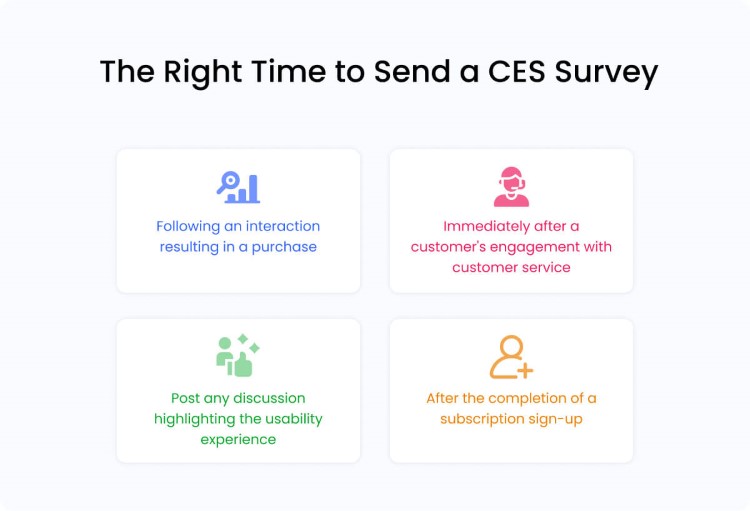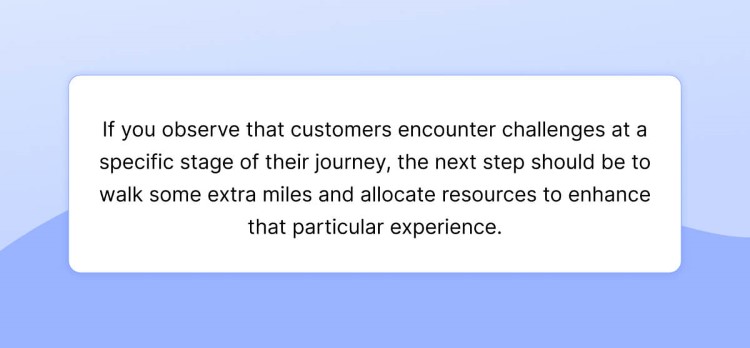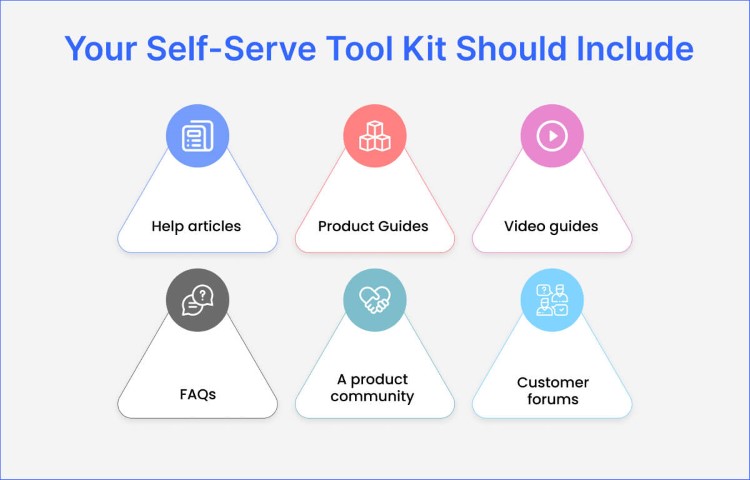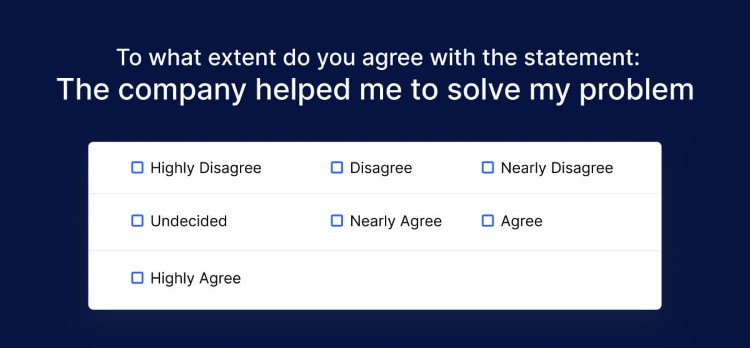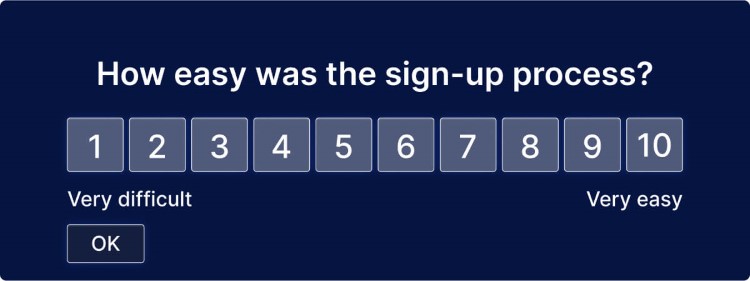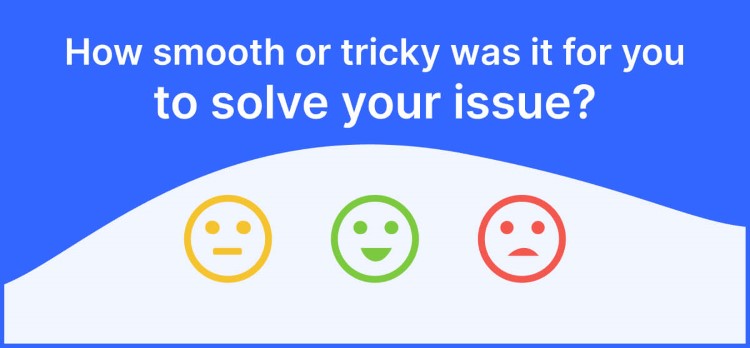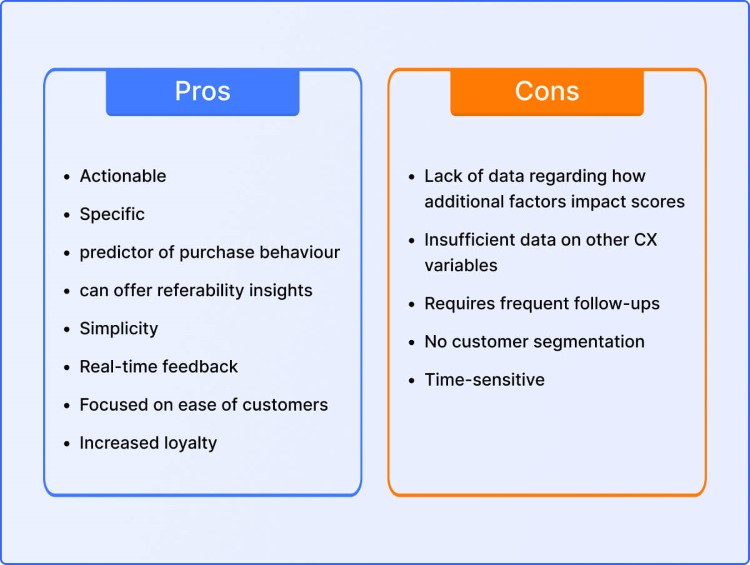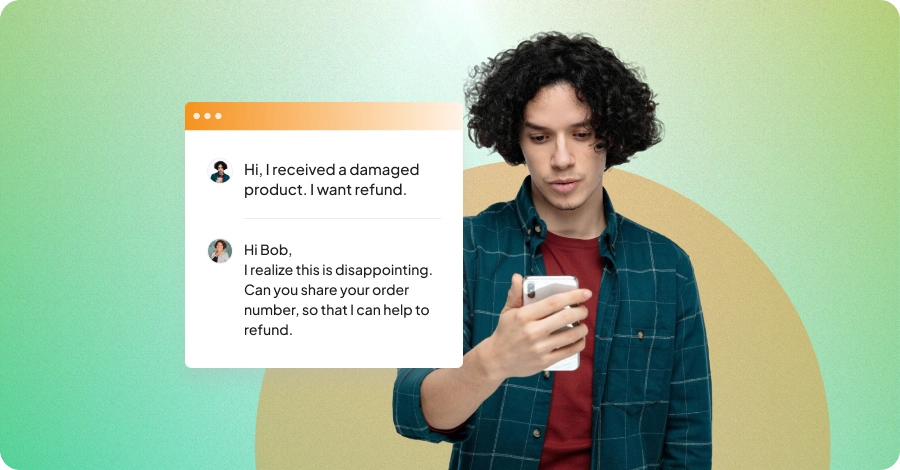Solving the Puzzle: Customer Effort Score & How to Calculate It?
- November 23, 2023
- 14 mins read
- Listen

In the present digital age of immediate gratification, convenience holds the throne. Whether it’s movies, music, or meals, they are all just a few clicks away. Nearly everything that once required a visit to a physical store can now be added to your online shopping cart.
As the purchasing process becomes increasingly seamless, your customer service experience must align. In a world where consumers are accustomed to obtaining what they need instantly, waiting in a lengthy queue and listening to some kind of recorded voice or tune is no longer their preference.
Determining the ease of interaction for the clients with your business can be a challenge for you. This is where the Customer Effort Score (CES) comes in. So, what is the customer effort score all about? If your goal is to retain more customers, it’s essential to gauge how effortlessly they navigate your processes by monitoring the CES. Subsequently, identify and implement new methods to enhance this score and make the customer experience even smoother.
This article will walk you through a comprehensive Customer Effort Score strategy, covering its influence on customer loyalty, how you can construct a CES survey, measure the score, and take necessary actions based on CES results. Let’s simplify things for you.
What is Customer Effort Score (CES)?
The Customer Effort Score (CES) is a metric within customer experience used to assess the ease of customers’ interactions with a business.
By monitoring CES and identifying its determinants, you can measure the level of effort exerted by customers in resolving support issues, fulfilling requests, completing transactions, and engaging with your product or company, whether online or in person. The ease of this experience is considered a valuable indicator of loyalty, making CES a widely favored tool among Customer Success teams.
It identifies the trouble areas for customers and provides feedback for your support teams to implement improvements. This may involve streamlining processes or providing additional training for employees directly interacting with customers.
In straightforward terms, the lower the effort required for a customer interaction, the higher your overall CES score is likely to be, and, the greater the customer satisfaction rate.
How to Calculate Customer Effort Score?
You can opt for various approaches to assess your Customer Effort Score, with common methods encompassing surveys, automated feedback capture, and direct interaction with your customers. Among these, surveys are the most prevalent. Keep reading to learn more.
The Likert Scale
A widely used approach to assess Customer Effort Score (CES), it incorporates multiple-choice questions crafted to measure an individual’s satisfaction level with their experience.
Typically, the questions cover both the general customer service and support experience, delving into specific details about each interaction. Respondents express their satisfaction levels by choosing a number from the Likert scale, which provides a range of indices measuring the degree of effort exerted to complete each interaction.
- 1-7
On the 1-7 scale, the assigned value to the range varies based on the specific question. Broadly, respondents are prompted to evaluate the level of effort required for a task. A response of 1-3 indicates low effort (positive response and a good customer effort score), while 5-7 signifies high effort (negative response).
On the other hand, when the question prompts respondents to assess the level of ease, you would anticipate 1-3 signifying a low value (a negative response), while 5-7 would denote a high value (a positive response indicating a positive customer experience and a good customer effort score).
- 1-5
Here the scale comprises five levels of difficulty: Very Hard – hard – Neither – Simple – Very Simple. The sequence is interchangeable.
Emoticons
Emoticons offer a straightforward, intuitive, and visual depiction of the customer’s overall experience with your brand. Displaying four emoticon faces representing very happy, neutral, unhappy, or dissatisfied, provides a swift means to assess their satisfaction during their engagement with your product offerings.
The Calculation
Once you gather all the responses, the Customer Effort Score is determined by computing the average of all individual responses to your CES survey questionnaire. To make it simple, subtract the sum of the response scores and then divide this result by the total number of your responses using the formula:
(Total of response scores) ÷ (Number of responses) = CES score.
Typically, CES scores for most companies fall within the range of 5 to 5.5. A score surpassing 6 is generally considered above average.
Enhance, Analyze, Succeed: The Benefits of Measuring CES
Armed with a profound comprehension of concealed customer pain points and valuable insights on enhancing the overall customer experience, let’s explore some more extensive advantages of measuring CES:
-
Predicts Future Repurchases
According to this study by the Customer Contact Council, one of the advantages of measuring CES lies in the valuable data’s predictive capability for future purchasing behavior. The study found that 94% of customers who reported low effort expressed an intention to re-purchase, with 88% acknowledging a high likelihood of increased spending.
Customers who gave high effort tend to provide lower ratings, signaling a reduced likelihood of repurchasing from the same business in the future. Conversely, customers encountering minimal effort are more inclined to give higher ratings and exhibit a greater likelihood of repurchasing from the same brand.
Therefore, if your business can consistently deliver customer experiences with minimal effort are likely to witness increased customer loyalty and repurchase rates. CES serves as a valuable tool for many companies aiming to pinpoint which customer service interactions contribute most to satisfaction, facilitating improvements in CX and repurchasing rates.
-
Indicates Likelihood of Customer Referrals
If a product or service meets your standards, it’s likely to meet the expectations of your friends and family as well. This widely accepted notion is the foundation behind CES’s ability to predict the likelihood of customer referrals.
By assessing consumer sentiment, considering elements like customer satisfaction, loyalty, and the inclination to make a purchase, CES helps you to understand the current state of customer relationships with your brand as well. Therefore, companies can boost customer referrals by enhancing the experiences of their current customers.
-
Provides Actionable Insights for Strategic Improvements
The insights derived from the Customer Effort Score will help you a lot as they precisely reflect the level of customer satisfaction when the survey was completed. This allows you to identify specific touchpoints, such as the ease of booking support tickets or calling your support team. By examining these details, organizations can take targeted actions to enhance the customer experience in areas that matter most to their users.
-
Pinpoints Specific Areas for Enhancement
CES surveys are brief and user-friendly, increasing the likelihood of high completion rates. However, you can effectively utilize the data obtained from these surveys if you can break it down into smaller segments.
Therefore, by examining customer effort scores over time, you can monitor shifts in overall customer satisfaction. This enables the identification of patterns and trends associated with varying levels of customer effort, providing insights into areas that require immediate attention and eliminating the need for guesswork.
Boost Your Customer Effort Score: 5 Proven Strategies
From restructuring workflows to offering supplementary customer support training, there are multiple approaches to enhance buyer satisfaction and reduce your customer effort score. Wondering how? Here are the 5 best strategies for your consideration.
1. Opt for Necessary Tools to Satisfy Customers
Establish a seamless experience for your agents, enabling them to extend the same to your customers. Equipping your team with a robust tech stack will definitely make it possible.
REVE Chat, for example, lets your support agents offer personalized assistance to your customers on their preferred platforms like websites, mobile apps, and other social media platforms like Facebook, Viber, Instagram, Telegram, Twitter, and WhatsApp.
REVE Chat serves as an omnichannel customer engagement platform, providing live chat and chatbot services to brands that are aiming to deliver exceptional customer experiences. The platform includes visitor analytics, revealing details like geographic location, past chat history, and real-time page views, empowering agents to provide personalized services.
Additionally, you can extend 24/7 customer support beyond business hours through the AI-powered REVE Chatbot. Interested in exploring its features? Take advantage of the 14-day FREE TRIAL. Sign Up today!
Once you integrate REVE Chat, you will get analytics about your agent’s performance and instant feedback from customers regarding potential enhancements that can empower your support team to better assist the clients.
Tips for Choosing the Best Customer Engagement Tool for Your Business!
- Clearly articulate your business objectives and define the specific goals you intend to accomplish using a customer engagement tool.
- Take into account the preferences and needs of your target audience.
- Choose a tool that offers multichannel support, facilitating seamless communication across various platforms.
- Verify integration capabilities with your existing systems, such as CRM software
- Look for features that automate repetitive tasks, enabling your team to concentrate on more intricate responsibilities.
- Prioritize tools that provide comprehensive data analytics and reporting capabilities.
- Select a tool that allows customization to match with your brand identity.
- Opt for a tool that provides a trial period or demo, allowing you to evaluate the tool’s compatibility with your business before making a commitment.
2. Deliver Training that Focuses on Solution-Oriented Support
Consistently examine the customer interactions as a team to identify collective opportunities for reducing CES. Engaging in call listening or monitoring chat history proves effective for coaching support agents. Recorded calls can also serve as illustrative examples for extra training.
Few Training Tactics:
- Ensure that agents have a thorough knowledge of your offerings. It is not a good strategy to place a customer on hold while your agent seeks a more knowledgeable teammate to answer his queries.
- Empower agents with the authority to address customer issues. If they continually need to seek permission to make decisions resolving customer issues, it can delay the whole process.
- Customers seek interactions with polite and friendly agents who listen, resolve problems, and communicate smartly. Ensure your teams hone these essential soft skills.
3. Present a Self-Service Option for Enhanced Customer Assistance
Do your agents frequently handle password reset requests from customers and basic straightforward queries? Employ AI-powered chatbots to manage such routine support requests instead.
Bots can swiftly address the most basic and common queries, streamlining interactions for faster and more convenient customer experiences. When coupled with additional self-service tools like FAQ pages and knowledge bases, they also relieve the workload on your support team, allowing them to focus on assisting customers with more intricate issues.
By minimizing wait times and offering abundant resources for customers to self-solve, you remove unnecessary friction and empower your customers to obtain the solutions they require by themselves.
Additional Tips:
- Guarantee that your self-service platform features an intuitive and user-friendly interface, enabling customers to navigate effortlessly.
- Clearly convey the presence of self-service alternatives to customers through diverse channels, ensuring they are well-informed about the available options.
- Routinely evaluate the efficacy of your self-service offerings and implement essential enhancements based on valuable customer feedback.
- Confirm that self-service resources are available across a range of channels, encompassing your website, mobile app, and social media platforms, to cater to diverse customer preferences.
4. Offer an Omnichannel Support Service
Nowadays customers seek omnichannel customer service, where they can effortlessly shift conversations between different support channels. Providing this experience is vital for reducing customer effort and enhancing retention.
According to Forrester, 43% of organizational leaders find that establishing omnichannel experiences is among the most demanding aspects of enhancing customer experience. Additionally, 43% note an increase in customer demands for omnichannel experiences.
REVE Chat’s unified agent workspace offers your team a centralized hub to receive and access all customer tickets and communication from different channels. Agents can seamlessly switch between tickets and chat interactions ensuring that pertinent context is always retained. With all customer information readily available in one dashboard, it streamlines and expedites the process for agents to address customer issues.
Best Tips:
- Opt for a customer engagement tool that consolidates all customer interactions from different channels into a single dashboard.
- Integrate diverse support channels, such as chat, email, phone, and social media, into a unified system.
- Enable customers to seamlessly switch between channels without losing context, ensuring a smooth transition and eliminating the need to repeat information.
- Ensure real-time synchronization of customer data across all channels, providing accurate and up-to-date information for both customers and support agents.
- Incorporate customer feedback mechanisms across all channels to gather insights and continually enhance the omnichannel support experience.
- Harness advanced analytics to monitor and analyze customer interactions across channels, pinpointing areas for improvement and optimizing the overall customer effort.
5. Delve into Customer Data to Gain Valuable Insights
Assess the feedback from your customers to gain a deeper understanding of the factors influencing their CES rating. If necessary, engage with buyers through follow-up inquiries to inquire about any challenges they encountered while using your products or services.
Segment your CES analytics to pinpoint areas requiring improvement. For instance, compare the CES scores for each of your customer support channels. If your customers find it “very simple” to obtain answers through phone customer service but perceive the help desk as “difficult,” it becomes evident which channel needs specific attention.
You may also categorize your support requests based on departments, such as “Account Creation” or “Shopping.” If the CES for a specific department indicates high effort, just go through customers’ open-ended survey answers to pinpoint potential roadblocks in the process.
Important Tips:
- Explore customer data extensively, examining interactions, preferences, and behaviors to derive valuable insights into their experiences.
- Analyze both quantitative and qualitative customer feedback to comprehend the factors influencing their effort scores and identify areas for enhancement.
- Incorporate various data systems for a consolidated perspective on customer interactions, facilitating a seamless analysis of their journey across diverse channels.
- Evaluate your customer effort scores against industry benchmarks to measure performance and highlight areas requiring improvements.
- Encourage collaboration among different departments to cultivate a comprehensive understanding of the overall customer experience.
Tell Us How We’re Doing: Sample Customer Effort Score Questions
Till now I hope the CES concept is clear! Now Let me show you some examples.
-
The Likert Scale
Responses to a CES Survey questionnaire in the Likert Scale typically range across a spectrum from “Highly Disagree” to “Highly Agree” (Highly Disagree – Disagree – Nearly Disagree – Undecided – Nearly Agree – Agree – Highly Agree). To enhance clarity, these responses are often assigned numerical values from 1 through 7 and may be color-coded, often progressing from red to color green.
-
The Numeric Scale
In this customer effort score survey approach, customers provide a response on a scale of 1 to 10 to your query. A good customer effort score survey responses typically fall within the 7-10 range.
-
The Emoji Survey Scale
This scale is extremely user-friendly and enjoyable for respondents, making it particularly valuable when conducting numerous customer effort score surveys for minor aspects of your product offerings, customer service, or website.
Customer Effort Score Survey: Sample Questions
- How much effort did you invest in resolving your problem?
- How quickly were you able to address and resolve your issue?
- Was our customer service agent efficient enough to resolve your issue?
- On the whole, how simple was it for you to resolve your issue with (insert the name of the assigned customer support agent)?
- How seamless was the process of navigating through our website/application to accomplish your goal? (1 being not seamless at all, 7 being extremely seamless)
- How much effort did you have to put into understanding and using our product/service features? (1 being very little effort, 7 being a significant amount of effort)
The Pros and Cons of Customer Effort Score (CES)
Bottom Line!
Keep in mind that the aim of a CES is not solely to boost customer loyalty but also to reduce the presence of dissatisfied customers who might adversely impact your brand reputation and hinder future goals.
You can now easily develop your customer effort score surveys as I have already listed above the best strategies and tips for you! Next, you need to consistently monitor, get a good customer effort score, and take actionable steps based on your results.
Monitoring and responding to a Customer Effort Score can significantly enhance your product value, refine business processes, and contribute to the overall lifetime value of your customers. So, why wait? Take action now!

